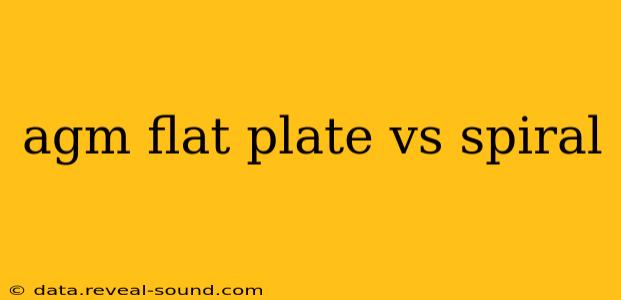AGM Flat Plate vs. Spiral: A Deep Dive into Battery Technology
Choosing the right battery for your application can be a daunting task, especially with the variety of technologies available. Two prominent contenders in the AGM (Absorbent Glass Mat) battery market are flat plate and spiral wound designs. This comprehensive guide will dissect the key differences between AGM flat plate and spiral batteries, helping you make an informed decision.
What are AGM Batteries?
Before delving into the specifics of flat plate versus spiral designs, let's briefly define AGM batteries. AGM stands for Absorbent Glass Mat, referring to the technology used within the battery. A thin, fiberglass mat is saturated with electrolyte, separating the battery plates and preventing spillage. This design makes AGM batteries leak-proof, robust, and suitable for a wider range of applications compared to flooded lead-acid batteries.
H2: AGM Flat Plate Battery Design
AGM flat plate batteries feature a traditional design where the positive and negative plates are arranged in a flat, parallel configuration. These plates are separated by the absorbent glass mat, all housed within a robust casing.
Pros of Flat Plate AGM Batteries:
- Cost-effective: Generally, flat plate AGM batteries are less expensive to manufacture, translating to lower prices for consumers.
- Established Technology: This design has been around for a long time, making it a well-understood and reliable technology.
- Wide Availability: Flat plate AGM batteries are readily available from numerous manufacturers and distributors.
Cons of Flat Plate AGM Batteries:
- Lower Power Density: Compared to spiral wound designs, flat plate batteries typically have a lower power density, meaning they offer less power per unit volume.
- Slower Charge Acceptance: They may take longer to charge compared to spiral wound batteries, especially under high-current charging conditions.
- Less Vibration Resistance: The flat plate design might be more susceptible to damage from vibration compared to the more robust spiral design.
H2: AGM Spiral Wound Battery Design
In contrast to flat plate designs, AGM spiral wound batteries employ a unique construction. The positive and negative plates are wound together in a spiral configuration, along with the absorbent glass mat. This creates a compact and efficient design.
Pros of Spiral Wound AGM Batteries:
- Higher Power Density: The spiral design maximizes the surface area of the plates, leading to significantly higher power density compared to flat plate batteries.
- Faster Charge Acceptance: The increased surface area also allows for faster charge acceptance, reducing charging time.
- Improved Vibration Resistance: The spiral construction is generally more resistant to damage from vibration and shock.
- Longer Cycle Life (Often): In many cases, spiral wound batteries demonstrate a longer cycle life, especially under demanding applications.
Cons of Spiral Wound AGM Batteries:
- Higher Cost: The more complex manufacturing process typically results in higher costs compared to flat plate batteries.
- Less Widely Available: Spiral wound AGM batteries might be less readily available than flat plate batteries, depending on your location and supplier.
H2: What is the Difference in Performance?
The primary performance difference lies in power density and charge acceptance. Spiral wound batteries excel in applications requiring high power output in a compact size, such as electric vehicles or backup power systems with high surge demands. Flat plate batteries are more suitable for applications where cost is a major factor and power requirements are less demanding.
H2: Which Type is Better for My Needs?
The "better" battery depends entirely on your specific application. Consider these factors:
- Power Requirements: Do you need high power output or is a moderate level sufficient?
- Budget: Are you looking for the most cost-effective solution, or is performance a higher priority?
- Space Constraints: Is size a critical factor?
- Cycle Life Requirements: How many charge-discharge cycles do you anticipate?
- Vibration Exposure: Will the battery be subjected to significant vibration or shock?
By carefully considering these factors, you can select the AGM battery that best meets your needs.
H2: Are Spiral Wound Batteries Always Better?
While spiral wound batteries offer advantages in power density and charging speed, they aren't inherently "better" than flat plate batteries. Flat plate designs remain a reliable and cost-effective option for many applications. The optimal choice is a function of the specific demands of your project.
H2: What about Deep Cycle Applications?
Both flat plate and spiral wound AGM batteries can be designed for deep-cycle applications (repeated deep discharges). However, specific battery specifications regarding depth of discharge and cycle life should be carefully reviewed before selection. Consult the manufacturer's data sheets for relevant information on suitability for your intended use.
This in-depth comparison should assist you in understanding the nuances of AGM flat plate and spiral wound battery technology. Remember to always consult the manufacturer's specifications to ensure compatibility with your particular application.
